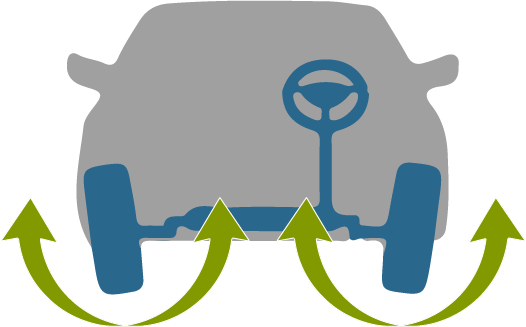3D 4 Wheel Alignment
Reasons for needing your Wheels aligned.
When your vehicle is out of alignment then problems will occur, such as
- Irregular tire wear - Excessive wear to the inside, outside or both edges of the tyres
- Excessive wear to wheel bearings and other mechanical components
- Increased fuel consumption
- Handling problems - Poor handling, Heavy steering, Vibration through the steering wheel
- Crooked steering wheel - Steering wheel out of alignment
A common indicator of misalignment is irregular tire wear. The wear begins on the shoulder of the tire or tires and continues until corrected which may lead to a significantly shortened tire life.
Another indication of misalignment is a pull to one side or the other requiring a constant correction to maintain a straight path.
Additionally a crooked steering wheel indicates your vehicle needs in alignment, especially if your vehicle has driver assist systems (ADAS) which typically rely on data from the steering angle sensor to function properly.
So if you see a shift in the position of your steering wheel, irregular tire wear or if your car is pulling to one side or the other you need to get an alignment check as soon as possible.
Some alignment conditions can be corrected with simple adjustments while others may require parts to be replaced. Ignoring these signs can make your alignment problems more expensive to address down the road, can reduce the life of your tires and can even cause driver assist systems (ADAS) to malfunction.
These alignments are classed as Camber, Toe (Track) and Castor.
So What is Camber, Toe(Track) and Castor?
Camber
This is the inward or outward angle of the tyre when viewed from the front of the
vehicle. Too much inward or outward tilt, also known as negative and positive camber,
respectively, indicates improper alignment and will need to be adjusted. Worn bearings,
ball joints, and other wheel-suspension parts may contribute to camber misalignment.
Toe (track)
Toe alignment is the extent to which your tyres turn inward or outward when viewed from above. Both require adjustment.
Castor
Your caster angle helps balance steering, stability, and cornering. Specifically, it’s the angle of your steering axis when viewed from the side of your vehicle. If you have positive caster, the steering axis will tilt toward the driver. Negative caster, on the other hand, means the steering axis tilts toward the front of your vehicle.
The below image's represent the angles for Camber/ Toe(track) & Castor
How We can Help
At Sam Harris Automotive We offer 3D 4 Wheel Alignment using our F-CAR EUROPE FD305 system.
Easily diagnose Tyre wear & Deviation problems.
Delivering accurate adjustments, correction of the deviation of the vehicle, Prevention of uneven or asymmetric tyre wear plus Steering wheel centring to ensure your tyres last longer and you drive safer.




